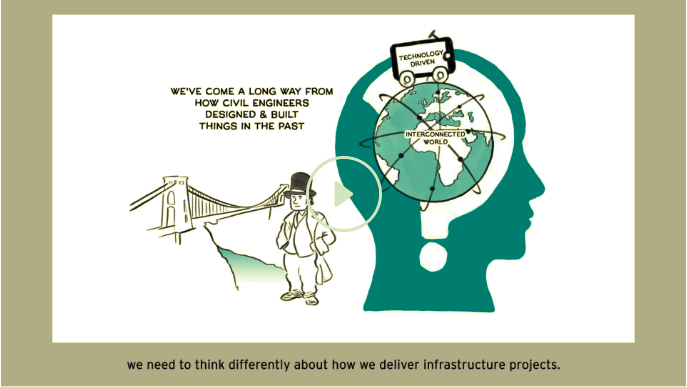A systems approach to infrastructure delivery SAID

|
Contents |
[edit] Introduction to SAID
Traditional civil engineering, while remaining a large capital cost, now exists to support a system that is made up of multiple physical, digital and human components. For example a new tunnel, would exists to support a system such as a railway that includes physical trains, stations and a track; digital signalling, safety and communications; as well as human components such as the procedures followed by drivers. As such the sector struggles to deal with projects that increasingly require complex systems to be planned, delivered and, most importantly, integrated to provide mobility, energy, sanitation and other numerous infrastructure services on which people depend.
The accepted approach to delivering complex infrastructure projects is therefore as a result, and in many ways facing, obsolescence. In 2020, ICE carried out more than 30 interviews with project practitioners from the infrastructure, aerospace, defence, oil and gas, and technology sectors to gather insights into the industry. A detailed literature review was also conducted with the help of Professor Andrew Davies, one of the UK’s leading academic specialists in systems integration and complex projects. These insights were used to create a Systems Approach to Infrastructure Delivery (SAID) that can be used to help deliver better outcomes for infrastructure owners and users.
[edit] Related initiatives
This work complements a number of other initiatives seeking to push the industry in a similar direction. These initiatives, driven by the Infrastructure and Projects Authority and the Construction Leadership Council, are also a rich source of insight, tools and case studies for any organisation looking to implement the SAID model. Here are some of the most relevant.
[edit] Infrastructure and Project Authority - Project Initiation Routemap
The Project Initiation Routemap was first issued in 2013, then in 2016 and updated 2021. It condenses a large amount of best practice into a single step tool with 8 modules to help assess the complexity of a project environment and the capabilities needed to manage it. The modules cover; requirements, governance, systems integration, organisational design and development, procurement, risk management, asset management delivery planning, the most recent report can be downloaded via the link below:
[edit] Infrastructure and Project Authority - Transforming Infrastructure Performance programme
The Transforming Infrastructure Performance programme builds on the IPA’s 2017 report, which was updated in 2021. It aims to ensure that public sector projects are selected, initiated and integrated into the UK’s infrastructure systems in a way that maximises their whole life performance in line with the Government’s social, environmental and economic objectives. The most recent report can be downloaded via the link below:
https://www.gov.uk/government/publications/transforming-infrastructure-performance-roadmap-to-2030
[edit] UK Government- Construction Playbook
The Government, working with the construction industry created the Construction Playbook to support the delivery of ‘faster, better, greener’ infrastructure providing value for money, while supporting a more stable supply chain. It in effect forms a compact between Industry and Government on the planning, evaluation, contract selection and implementation of new projects. It was last issued in 2020 by the cabinet office under an Open Government Licence, available via this link:
[edit] Construction Leadership Council CLC
CLC is involved in a variety of initiatives such as: Project 13 and CO2nstruct Zero, as well as The Centre for Digital Built Britain (CDBB), to understand how the construction and infrastructure sector can use digital approaches for better design, build, and operational performance through integration in the built environment. As of April 2022 this work will transition to CIOB. For more information see the links below:
https://www.constructionleadershipcouncil.co.uk
[edit] Defining a systems approach
Systems thinking means embracing the idea that the whole is more important than the sum of its parts. In the simplest terms, it means understanding how all of the component parts of a project work together to meet a common objective. As projects become more complex, it also helps project leaders understand how individual assets will contribute to the performance of the wider networks in which they sit.
Systems engineering is the application of systems thinking to engineering design and management. It helps different teams working on individual components of projects to stay aligned to a common goal.
Systems integration is the practical task of bringing together all of these components and taking them into service as a single, fully-functioning system.
The ‘extended system’ refers to the sociopolitical environment in which a project is to be delivered and the many – often hundreds – of stakeholders who can influence it.
[edit] SAID report part 1
The industry and literature review revealed enormous support for much greater use of systems thinking in how the infrastructure industry delivers complex projects. It heard that a systems approach could provide better outcomes for owners and users and help the sector to make progress with its great strategic challenges, not least its contribution to achieving net-zero carbon emissions by 2050. The review has used these findings to propose a new Systems Approach to Infrastructure Delivery. The SAID model has eight components.
- Outcome not edifices: Owners must clearly define the user outcome, so that engineers and technology developers can deliver for that use.
- Close the gap: Close the gap between infrastructure and sectors adapting better to technological change. Cherry-pick best practices to improve delivery efficiency.
- Owners must own projects: Owners should give direction on everything, from functional requirements for the operational system to data requirements and acceptable technology and innovation risks.
- Future proof projects: Use the V-cycle process to establish systems architecture, manage technology development and upgrade it with minimal disruption.
- Think shovel worthy, not shovel ready: Front-end project development gives clearer project definition, creates a more stable delivery environment and improves stakeholder engagement and management.
- Bake in systems thinking: Bake systems thinking and risk management into the project DNA. Design an organisation and structure that mirrors how you’re going to manage risk.
- Agile leadership: Agile leadership adapts to multiple risks in complex systems. Spread authority through empowerment models that listen to the right voices at critical moments, enable skilled front-line people to make decisions and support baton handovers.
- Data oils your project: Owners should define the vital data for delivering the service, the appropriate collaboration model and share it through the supply chain. Collaborating around shared data increases productivity, enables integration and improves operational performance.
[edit] Recommendations
To help create an environment in which the infrastructure sector can deliver a Systems Approach to Infrastructure Delivery, the review has identified actions for the Government, the Construction Leadership Council and ICE in the following areas: construction readiness, future leaders, data-driven planning, project delivery and asset management.
The full report can be downloaded via this link: https://www.ice.org.uk/knowledge-and-resources/briefing-sheet/a-systems-approach-to-infrastructure-delivery
[edit] SAID Report Part 2
The second part of the SAID report is to be published at the and of April 2022, more information as well as the webinar launch details can be found at the top of this page. This work on how a more whole-systems approach can improve infrastructure project delivery and secure better outcomes for asset owners and the public, follows with the second report looking at how the complexity of modern infrastructure projects can be simplified.
[edit] Webinar
20th April webinar to engage with industry leaders and learn about applying the eight principles. Register at: https://myice.ice.org.uk/events/event-registration?eventid=8304
At this launch event, review chair Andrew Mc Naughton, infrastructure sector lead at Aczel, will be joined by representatives from the six featured projects – Tideway, Crossrail, East West Rail, the British Antarctic Survey’s Infrastructure Investment Programme, Anglian Water’s Strategic Pipeline Alliance, and the development of major contractor Costain’s Systems Approach Capability. These case studies have given us a deeper understanding about how those eight principles can support the delivery of modern infrastructure projects.
This article is based on reports, articles and blogs available via the ICE website, links have been given in the text above.
--Institution of Civil Engineers
[edit] Related articles on Designing Buildings
- Achieving sustainable roads funding in England.
- Articles by ICE on Designing Buildings Wiki.
- Connected procurement.
- Data and infrastructure productivity.
- Digital Built Britain.
- Digital communications and infrastructure dependencies.
- Digital engineering.
- Digital transformation - engineers need to keep pace.
- Market.
- Project 13 and World Economic Forum partnership.
- State of the nation: Digital transformation.
- The impact of digital on civil engineering.
- UK Digital Strategy.
Featured articles and news
Delivering for tenants; National Retrofit Hub
New report offers recommendations to strengthen energy efficiency standards to protect private renters.
Government consultations for the summer of 2025
A year of Labour, past and present consultations on the environment, the built environment, training and tax.
CMA competitiveness probe of major housing developers
100 million affordable housing contributions committed with further consultation published.
Homes England supports Greencore Homes
42 new build affordable sustainable homes in Oxfordshire.
Zero carbon social housing: unlocking brownfield potential
Seven ZEDpod strategies for brownfield housing success.
CIOB report; a blueprint for SDGs and the built environment
Pairing the Sustainable Development Goals with projects.
Types, tests, standards and fires relating to external cladding
Brief descriptions with an extensive list of fires for review.
Latest Build UK Building Safety Regime explainer published
Key elements in one short, now updated document.
UKGBC launch the UK Climate Resilience Roadmap
First guidance of its kind on direct climate impacts for the built environment and how it can adapt.
CLC Health, Safety and Wellbeing Strategy 2025
Launched by the Minister for Industry to look at fatalities on site, improving mental health and other issues.
One of the most impressive Victorian architects. Book review.
Common Assessment Standard now with building safety
New CAS update now includes mandatory building safety questions.
RTPI leader to become new CIOB Chief Executive Officer
Dr Victoria Hills MRTPI, FICE to take over after Caroline Gumble’s departure.
Social and affordable housing, a long term plan for delivery
The “Delivering a Decade of Renewal for Social and Affordable Housing” strategy sets out future path.
A change to adoptive architecture
Effects of global weather warming on architectural detailing, material choice and human interaction.
The proposed publicly owned and backed subsidiary of Homes England, to facilitate new homes.
How big is the problem and what can we do to mitigate the effects?
Overheating guidance and tools for building designers
A number of cool guides to help with the heat.
The UK's Modern Industrial Strategy: A 10 year plan
Previous consultation criticism, current key elements and general support with some persisting reservations.
Building Safety Regulator reforms
New roles, new staff and a new fast track service pave the way for a single construction regulator.


























